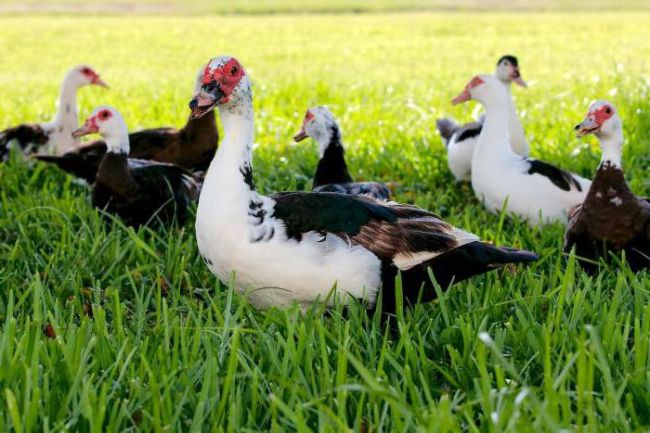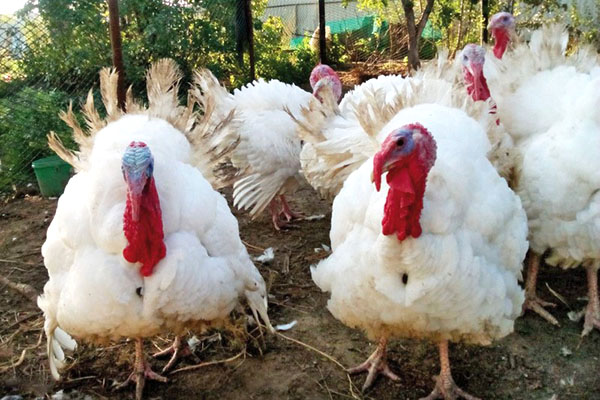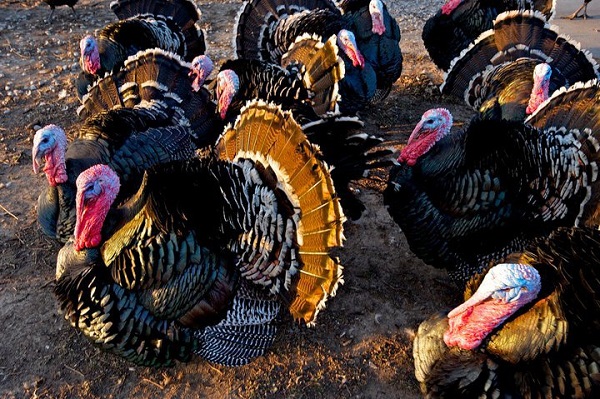AND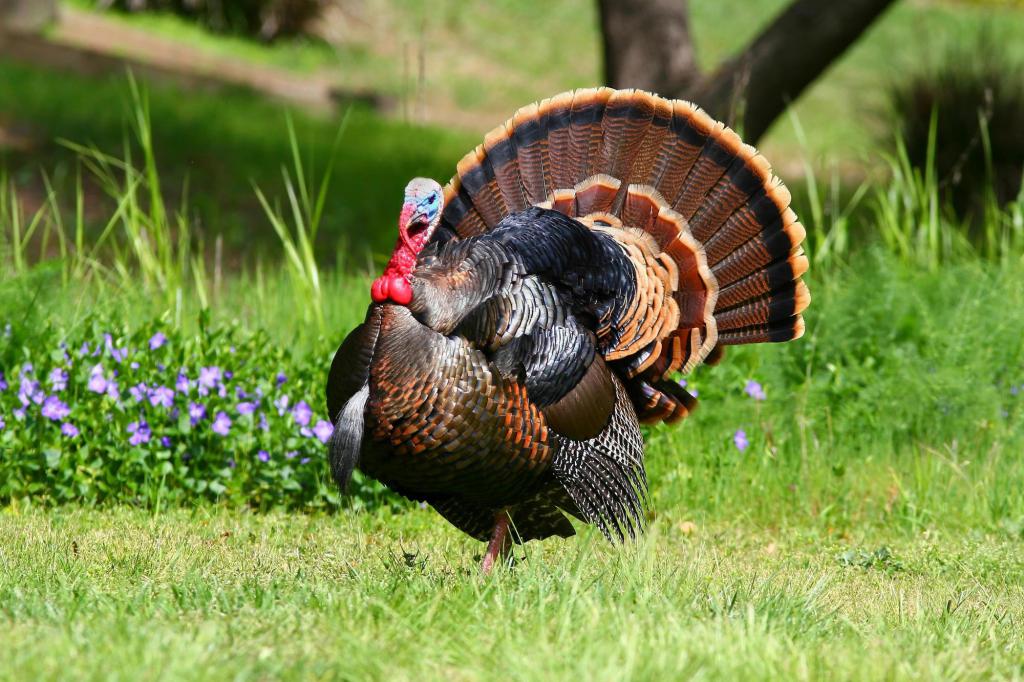
Such beautiful and majestic birds as turkeyssuitable for private use. But keep and care it’s not easy, especially for novice poultry farmers.
Content
- 1 How profitable to grow turkeys at home?
- 2 The most suitable breeds for farming
- 3 Turkey Care Highlights
- 4 What should be the room
- 5 How to walk turkeys
- 6 Meat-feeding of young individuals in a private farm
- 7 Farm breeding turkeys
- 8 How to feed birds for normal timely growth
- 9 Turkey production
- 10 What can domestic turkeys hurt?
- 11 Growing turkeys is a business
- 12 Professional Tips
How profitable to grow turkeys at home?
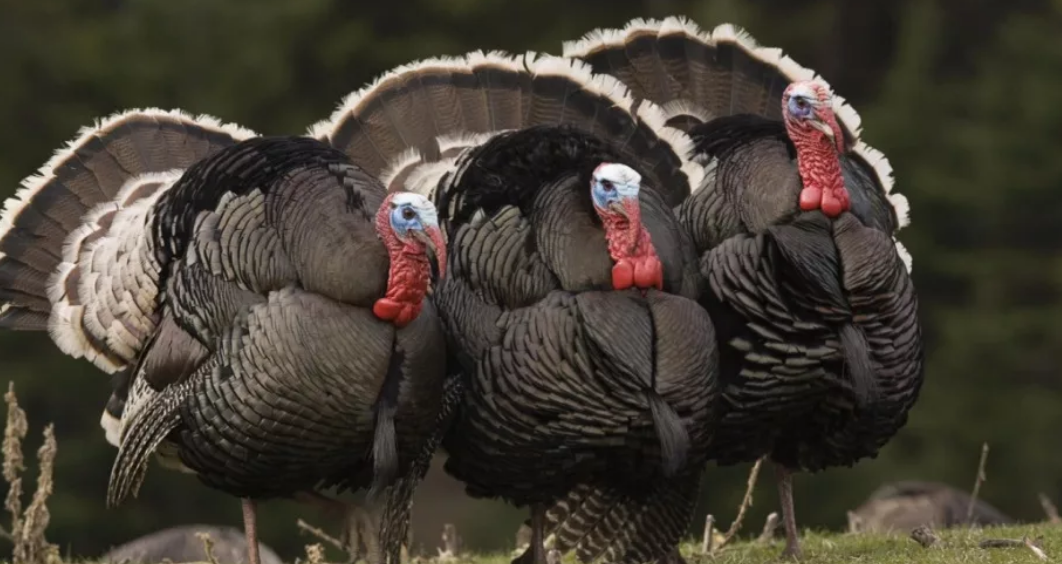
Private farmers increasingly prefer to deal with these birds. Someone turns them on for personal use of the products, others often sell turkey meat and eggs on the market. The content of turkeys has its positive and negative sides. Those who wish to engage in the cultivation of turkeys, it is advisable to evaluate the possible advantages and disadvantages.
The advantages of growing birds:
- low-calorie turkey is a very useful product that contains a minimum of cholesterol, vitamins, amino acids, trace elements;
- expenses for keeping individuals pay off in a short time;
- in order to generate income in the market, you can sell not only meat and eggs, but also feathers and fluff;
- turkeys quickly add to the mass;
- birds are not capricious to living conditions and undemanding to food.
Some poultry farmers do not dare to deal with turkeys, arguing this with a number of shortcomings:
- low productivity - these birds give much less eggs than hens;
- newborn chicks often die;
- individuals require fresh water at room temperature;
- turkeys often get sick, especially if hygiene rules are violated;
- birds ckare obese.
The most suitable breeds for farming
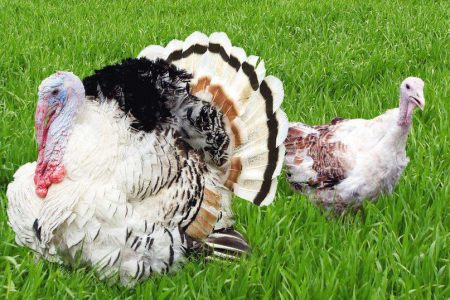
It is important for the poultry breeder who decided to breed turkeys not to be mistaken with the breed. She is selected, according to the tasks, wishes of the farmer and methods of maintenance. Before buying birds, you need to pay attention to the distinctive features and features breeds, because only in this case it is possible to provide to the birds competent care. There are several very famous breeds in the Russian Federation:
- Bronze Males have red-brown feathers and a black neck; females are modestly colored. They can be kept outdoors without much maintenance.
- Moscow bronze. Resistant breed, suitable for both private land and industrial breeding. It has a relief chest, an elongated body. Feels great walking in the pasture.
- Broad-chested bronze. It looks like its predecessor, but more dense and massive. The ability to carry eggs is low; walking the bird is undesirable. More suitable for breeding on large farms.
- Bronze North Caucasian. It originated in the USSR in 1946. One of the most popular domestic breeds of turkeys. Large individuals easily adapt to different conditions.
- White broad-chested. It has an oval body, voluminous chest, massive back, lush plumage, tight legs. Gives low-calorie meat and eggs.
- White North Caucasian. Unpretentious individuals with high fecundity and rapid increase in body weight. It is easily kept on pastures, not capricious to food.
On average, the weight of a bird is from 7 to 15 kg., And the number of eggs laid per year is from 70 to 100.
The homeland of turkeys is America.Domestic birds became 1000 years ago, and in Europe they appeared in the 16th century.
Turkey Care Highlights
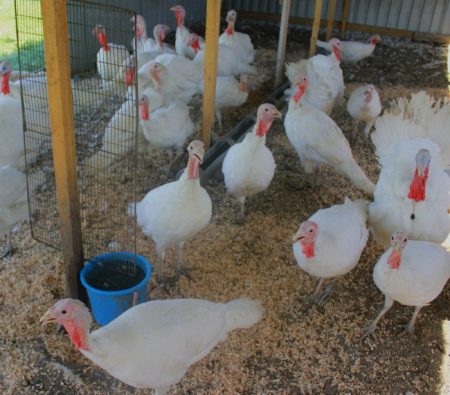
Etee birds unpretentious and survive at temperatures up to -15, but dry and warm air is better for them. It is necessary to control the level of dampness in the pen, and put a comfortable litter on the floor so that the legs of the birds are warmed. This must be done at least 2 times a week. Each room must be provided with boxes of small size with ash and sand so that parasites do not appear there.
Youngsters need special care. Newly born chicks are most in need of a dry and warm environment. A box or box is suitable for this. The temperature in temporary housing should be at least +36 degrees, there should be maintained high-quality lighting. Mature chicks are placed in a common pen. By equipping the nest, its edges are raised high so that the brood hen is isolated from other birds.
What should be the room
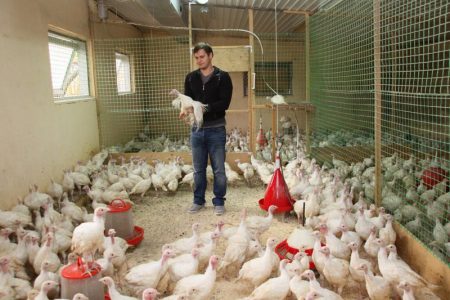
Literate poultry farmers have a number of requirements for the place of keeping and profitable breeding of turkeys. To equip the house, you must adhere to the following algorithm:
- Choose the size of the room. Such a calculation is desirable: at least 1 sq. Km. m. for 2 individuals., and preferably one.
- Adjust the temperature in the prepared paddock, which should be at least 5 degrees in winter and 20 in summer.
- Set the light. You can use a simple 60-watt light bulb.
- Set perches according to the number of turkeys in the pen. There should be 1 perch per 1 individual, and the distance between them is 60 cm.
- Check ventilation to reduce humidity.
- Adjust roost level. Norm - 70-80 cm from the floor, width 5-7 cm, height 8-10 cm.
If the birds are in the same pen in the group there should not be more than 5 layers per male, otherwise their productivity will be low.
In addition to the main nuances for the competent cultivation of turkeys, it is necessary to provide containers for food and water, perches, nests, aviaries for walking in the summer.
How to walk turkeys
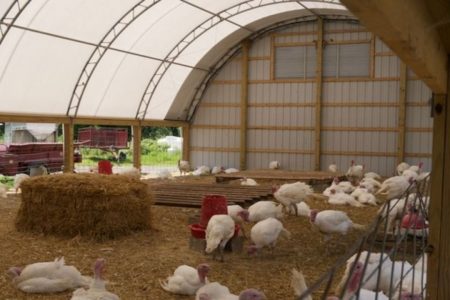
One of the characteristics of poultry is obesity, so they need to walk more. In the open air, birds receive useful food in the form of worms, insects, greens, nuts, seeds. Turkeys need to be more often in the shade to hide from the heat. You can walk the birds in special enclosures on the street. There they put feeders with barley and oats, containers with water, which is constantly changing.
The most important thing is to walk in the winter, when the birds are taken out to the open air for several hours in the absence of wind. The walking area is lined with a large layer of straw so that individuals do not freeze their legs. Food is scattered for bait turkeys on the street. If they are represented in large numbers, you can create small groups led by males.
Meat-feeding of young individuals in a private farm
On farms, meat birds of different age categories are grown. Young individuals are kept and fed until their breeding becomes unprofitable and there is a need to get rid of them. In private areas turkeys are fed meat, greasy or combined methods. For the second option, birds aged are suitable, for the first and third - healthy adolescents. As a rule, young animals unsuitable for breeding and extra males are killed.
There are breeds especially suitable for meat growing. This is the North Caucasian bronze, white and bronze broad-chested, broiler turkey Big-6.
Forced fattening
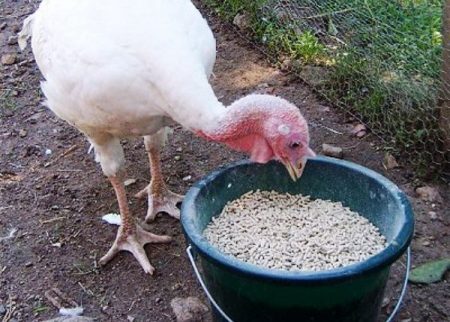
The bottom line is that the volume of food for turkeys is increased significantly. If an individual ceases to eat due to lack of need, it is forced to do this by placing food in the goiter.
First, the movement of the turkey is limited by planting it in a cage. He is given 700-800 g of food a day with a lot of fats and proteins.
For this method of feeding, soft foods are used so as not to harm the digestive tract.Namely, they make “mixers” of corn, barley and wheat.
If you force-feed a turkey, in 20 days it will double the rate of weight gain.
Farm breeding turkeys

Experienced poultry farmers are advised to start breeding grown young animals. It is advisable that individuals have 3-4 months. By the indicated time, they stably eat classic food, and their immune system is strengthened. If breeding starts from scratch, several birds of different sexes should enter the house: 1 male and 8-10 females. If there are more chickens, the manufacturer will not cope with its function.
Females hatch eggs for about a month. Birds are perched in the spring. For 1 individual, there should be 17 eggs freely located under it. If the turkey is inexperienced, she has just started mothering, she will not be able to plant many eggs. In the lower part of the nest they thinly sprinkle the earth and cover it with dry straw. The nest is put in a remote place, a container with water and a bowl of food are placed next to it.
A female turkey can raise about 80 chicks, including other species, such as ducks or chickens.
What are incubators and hens used for?
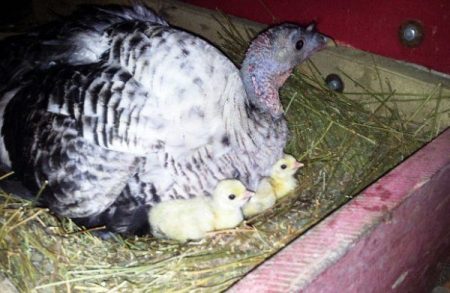
The turkeys have a perfectly developed maternal instinct: they know how to hatch, educate and protect the new generation. There are times when they are so keen on this activity that they don’t remember about food, then the hen needs to be removed from the nest and taken to the stern. During feeding, the females can inspect the eggs for damage, hatched chicks should be kept next to their mother for 6-8 weeks.
A private farm can use an incubator. Eggs that will be grown in this way must be taken from under the mother and put into the device. They are placed in the tray with the tip down to save enough space. Toddlers hatch after about 28 days. Before 22 days have passed, you need to turn the eggs over 12 times a day, with the goal of uniform heating. In addition, you need the right temperature mode. The closer the period to the appearance of chickens in the light, the warmer it should be inside.
How to feed birds for normal timely growth
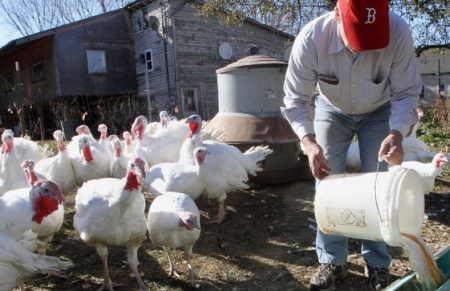
In order for individuals grown in private lands to be suitable for sale, their diet must be properly arranged. As a rule, farmers use mixed feeding. Turkeys are given sprouted grains, dry or wet mixes. In autumn and spring, turkeys are taken out to pasture for pasture, where they eat greens. Food should be combined with vitamins and nutritional supplements: finely chopped carrots, cabbage, beets. The dried steamed greens will not hurt.
Turkeys like oat and barley groats, but it is advisable to germinate plant grains. During breeding, pets are best fed 4-5 times a day. In the first half of the day they give raw food, in the second - dry. For the production of delicious and delicate turkey poultry, professionals recommend increasing the content of juicy components, gradually reducing the number of grains.
Chickens need to eat 8 times so that the brood is healthy in the future. 3 days after birth, they are given dry cereal mixed with chopped boiled eggs. Until the age of 1 month, babies are fed with small cereals, where greens are added: clover, lettuce, leaves of cabbage, nettle. Suppose also mixed feed, where there are all substances for full development.
Reproductive maturity
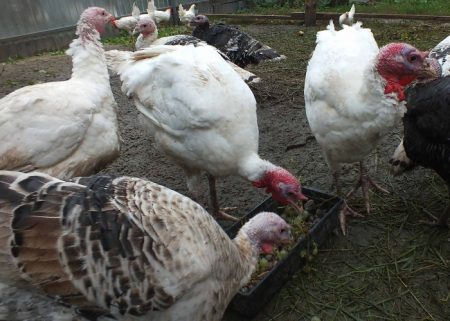
Reproductive functions in birds form in 8-10 months. Chickens produce eggs from 10 months of age. Pets should be closely monitored during this period and offered them food about 5 times a day. In the winter, wet grain food with the addition of carrots and vegetable flour is needed. In the hot season, any seeds and greens are suitable.Mature turkeys require a mixture of yeast, vegetables, herbs, seeds with sprouts and cottage cheese.
1 turkey egg weighs 70-90 g, that is, much more chicken. The shell is painted in pockmarked, not brown or white.
Turkey production
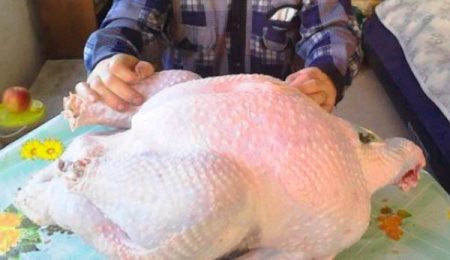
To get tasty meat, it is better to breed hybrid individuals, that is, breeds created by crossing. Farmers acquire chickens weighing no more than 50 g., Taken out of the incubator no earlier than 8 hours ago. The classic Russian technology for breeding these birds is as follows: adolescents are kept in cages for 8 weeks, and then placed on the floor. Babies need to eat vitamin feed. First, the birds are fed 8 times a day, then they reduce the number of meals to 4. The basics of cultivating turkeys for meat are the same for the “egg” specimens. The best time for slaughtering females is 16 weeks, males - 22 weeks.
What can domestic turkeys hurt?
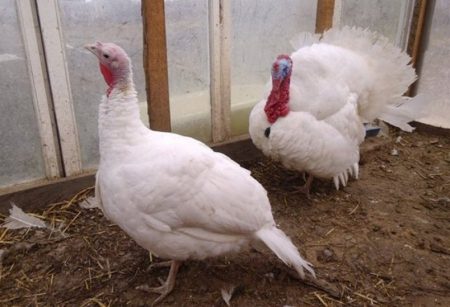
There are contagious infections that pass from one living creature on the farm to another. They can be caused by viruses. Most of them can be avoided by prophylaxis. Here are the main ailments of turkeys:
- Respiratory mycoplasmosis. Due to the high humidity in the room and the wrong diet.
- Tuberculosis. A very serious illness. It affects the upper respiratory system and lungs. She can be infected through contaminated bedding, untreated water, eggs, equipment.
- Histomonosis is a pathology of the cecum. It occurs in the digestive system of turkeys living in an uninfected house, where geese or hens were kept before.
- Worms. The most common disease related to the digestive and respiratory systems. They can be infected through soil, food, water and from other individuals.
- Smallpox. It cannot be cured, therefore sick birds are destroyed and then burned. Turkeys can become infected through water or food when interacting with unhealthy brethren.
To prevent pets from getting sick, compound feeds must be reliable, and the conditions in the pen must be decent. To do this, make it a rule to maintain order in the paddock, clean containers for water and food, constantly inspect and plant birds.
Growing turkeys is a business
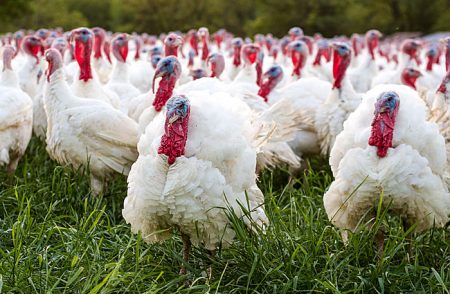
More and more poultry farmers are thinking of acquiring a turkey population. They are bribed by a little competition and a solid profit from such a thing. Breeding chickens is less profitable, because turkeys are larger, and their meat is dietary, with an unusual taste. Each bird brings about 100 eggs per year and 600 kg of meat with proper fattening. But when planning a business, you need to remember a few points:
- You need to find the right breed, familiarize yourself with the rules for keeping turkeys, buy the right equipment and raise money.
- Business needs a quality business plan, where all the nuances are sorted out. It is necessary to highlight the main stages of the business, assess the cash costs, indicate the estimated risks and income.
- Farming is registered with state bodies. There you can get a quality certificate, the consent of the veterinary service and SES.
- For breeding birds rent a place: a piece of land or a farm, equip a house. You need to buy not only turkeys on special farms, but also equipment for reproduction. Individuals need competent care.
- It’s not easy to sell products either. With sales methods are determined in advance. To do this, a market or retail outlets: shops, restaurants.
What is the advantage of growing turkeys?
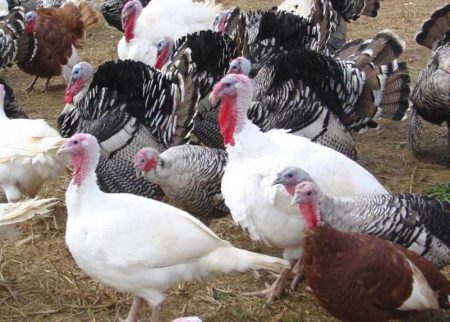
Of course, at the initial stage of business development, a lot of money will have to be spent on it. After all, the first months you need to take care of purchased teenagers, which requires substantial expenses. Be sure to pay for the construction of the pen, its heating, electricity, animal feed and the pets themselves. Not to mention utilities, for which you have to make payments every month.
But 6 months will pass and the proceeds collected from the sale of turkey and eggs will close the primary waste. Then a new livestock will appear on the farm and, accordingly, the next earnings.For example, if you initially buy 30 chicks and several mature birds, after 6 months you can already withdraw 150,000 profits. As the number of individuals increases, so does income.
Professional Tips
We have listed the main factors necessary for the development and weight gain of turkeys. If you do everything according to these recommendations, there will be no difficulties. However, experienced poultry farmers are advised to always remember the following:
- Turkeys cannot live without cleanliness and not only in the houses, but also on the territory of the range. It is necessary to thoroughly disinfect the premises, especially if hens or other birds once lived in them.
- The microclimate of the pen should not be disturbed, otherwise the birds will fall ill. The health of each individual must be watched, because there are infections that can destroy the entire population.
Growing turkeys in the private sector is an entertaining and profitable business even for a beginner who is not familiar with the intricacies. The main thing is to follow all the rules of keeping, provide birds with food on time, take care of adults who will bring worthy income.

